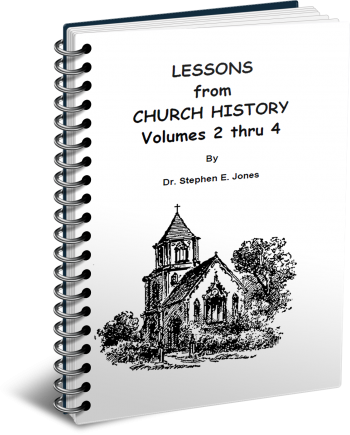Latest Posts
View the latest posts in an easy-to-read list format, with filtering options.

Volumes 2-4. This is the history of the Church from the Roman War (66-73 A.D.) to Constantine and the Council of Nicea in 325 A.D. with lessons to be learned from it.
Category - History and Prophecy

The Bar-Cochba revolt severed any remaining ties between Christianity and Judaism. Philip Schaff says that Bar-Cochba “caused all the Christians who would not join him to be most cruelly murdered” (History of the Christian Church, Vol. II, p. 37). Jewish authorities attest to this fact as well, though justifying it according to their particular viewpoints.
The destruction of the temple in Jerusalem in 70 A.D. understandably put the Jews into a great state of frustration and despair. They attributed this disaster to the policies of their enemies. The peace party blamed the war party, while the war party blamed the peace party for not having faith in God. Others felt that Jews were not being sufficiently scrupulous in law-keeping, by which they meant their traditions. Still others blamed the Christians and even their own countrymen for not persecuting them vigorously enough. Schaff writes on page 37,
“They caused the death of Symeon, bishop of Jerusalem (107); they were particularly active in the burning of Polycarp of Smyrna [155]; and they inflamed the violence of the Gentiles by calumniating the sect of the Nazarenes.”
But the twin disasters of 70 and 135 A.D. caused Judaism to withdraw into its protective shell in order to survive. The codification of the Jerusalem Talmud from the end of the second century to the fourth century completed these walls around Judaism, which served to protect and to imprison them at the same time in a rigid, traditional form of religion. Later, the Babylonian Talmud (430-521 A.D.) built the walls even higher.
The violent separation between Judaism and Christianity had another byproduct. While Judaism was pronouncing threats and curses upon Christians, another wall was being built around Christianity to defend against Jewish opposition. The Church as a whole began with a Hebrew thought process, but later adopted the Greek perspective, and finally gave it Roman interpretations. With this transformation, the Hebrew metaphors of the O.T. were given new meanings. The law was viewed as part of Judaism, identified as synonymous with Jewish traditions, and finally marginalized.
Whereas the Mother Church of Christianity had maintained close ties to the temple, Jewish persecution drove it into the Greek world, and it ultimately found a long resting place in Rome with its desire for military government, law and order, and structure. Rome then claimed primacy as Christianity's “mother,” when in fact it was neither the first Church nor even the first that Peter established.
The British Church, though vibrant and strong at the time, was too far away at the fringes of the Empire to have any significant influence in Italy, Greece, or Asia. For this reason, its history was largely lost, and the later Roman Church tried to forget its establishment before the Church of Rome.
In fact, if the British Church had had the same desire and ambition as Rome, they could easily have overthrown all Roman pretensions very early. But the British Church made no attempt to claim primacy over Rome, believing that they were equals. It was Rome that was then asserting its primacy over all others. Incidentally, this is not the same Augustine whose writings had such great influence in the Latin Church two centuries earlier. It was a later Augustine who was sent on a mission to Britain to bring that Church into subjection to the Roman bishop. When it refused, Britain was pronounced non-Christian, and thus Rome taught that Christianity was brought to Britain at a later date.
At any rate, when Christianity came to be adopted by Greeks outside of the synagogue, they turned to non-Hebrew sources to appeal to their brethren. When the philosopher Justin Martyr (110-165 A.D.) was converted, he used his knowledge of Greek philosophy to show that Moses preceded the Greek gods, and that the Greek gods were just imperfect relics and imitators of Biblical characters.
Justin's Dialogue with Trypho reconstructs a discussion that he had with Trypho (or Tryphon), who was one of the leaders of the Bar-Cochba revolt who had somehow survived that disaster. (Prof. Graetz writes about Trypho in the second volume of his History of the Jews.)
Even as the Greek world was subject to Rome in those days, so also was it perhaps inevitable that the Roman Church would claim primacy over the Greek Churches. This was not without dispute, of course, and in fact it finally came to a head in 1054 when the Greek Orthodox and Roman Catholic Church split permanently.
Even as there were three language-steps in the development of the Church (Hebrew to Greek to Latin), so also it is said that there were three doctrinal steps to Roman supremacy, represented by three Church fathers: Ignatius of Antioch (30-107 A.D.), Irenaeus of Lyons (died 202 A.D.), and Cyprian of North Africa (died 258 A.D.). Philip Schaff says that each contributed to Roman supremacy in his own way without realizing it.
Ignatius focused upon Church unity and seems to have been the first to set forth a clear doctrine of submission to the local Church Bishop, who stands as a Vicar of Christ. However, he also said that only Christ was the Universal Bishop of all the churches, and made no claim that any particular Bishop had supremacy over the other Bishops. In other words, as Philip Schaff tells us on page 148,
“The Ignatian episcopacy, in short, is congregational, not diocesan; a new and growing institution, not a settled policy of apostolic origin.”
In the latter part of the second century, Irenaeus, Bishop of Lyons, was mostly concerned about the rise of Gnosticism. Schaff says on page 149,
“This father represents the institution as a diocesan office . . . He exalts the bishops of the original apostolic churches, above all the Church of Rome, and speaks with great emphasis of an unbroken episcopal succession as a test of apostolic teaching and a bulwark against heresy.”
Whereas Ignatius had regarded the episcopate as a center of church unity, Irenaeus establishes it as the depository of apostolic tradition in arguing against the Gnostics. Whereas Ignatius had set forth the idea that men should submit to their local church authority, Irenaeus emphasized the authority of the Universal Church that was ruled by the bishops—essentially an Episcopal system.
Finally, Schaff says, Catholic episcopal thinking reached its maturity under Cyprian, who established the idea that salvation was possible only within the fellowship of the organized, physical Church. This meant that organized church on earth had now fully replaced the Universal Church made up of members whose names were written in the Lamb’s Book of Life. True Christians were those members in good standing, and God was thought to agree with whatever the bishop said. At that point, the great revolt was completed, for instead of man bearing witness to God, now God was bearing witness to man. Schaff tells us on page 150,
“Cyprian considers the bishops as the bearers of the Holy Spirit, who passed from Christ to the apostles, from them by ordination to the bishops, propagates himself in an unbroken line of succession, and gives efficacy to all religious exercises. Hence, they are also the pillars of the unity of the church; nay, in a certain sense they are the church itself. 'The bishop,' says he, 'is in the church, and the church in the bishop, and if any one is not with the bishop he is not in the church.' And this is the same with him as to say, he is no Christian.”
These three men, it is said, manifested the basic progression in the denominationalist structure.
There remained, however, one major step in the progression of denominationalism. It was the idea that salvation was possible only within the fellowship of the Roman Church. These roots were planted by Victor in 192 A.D. when he presumed to excommunicate virtually all of the Eastern bishops in the great Passover controversy. In doing this, he assumed power over the other bishops, which, in practice, meant the authority under God to determine which bishops were saved and which were not. Those who agreed with Victor were true Christians, the others were not.
This step in the history of Church organization took place long before Cyprian, who wrote in the middle of the third century. But Victor set the precedent for Bishop Stephen of Rome who took this new-found papal power to the next step. Stephen is often called “the first pope.”
There is no doubt that Victor would have been called the first pope in 192, if his excommunication orders had not been rescinded after Irenaeus admonished him by letters for his ill-conceived act. Though Victor ultimately had to back down, the precedent was set, which the Roman Church used later as “proof” of its supremacy.
Cyprian himself (248-258) disputed with Pope Stephen and refused to submit to him in the dispute over heretical baptism in his day. He probably died out of fellowship with Stephen in the persecution of Emperor Valerian. And so Cyprian cannot rightfully be used to prove papal supremacy. Cyprian merely established an Episcopal supremacy, where salvation lay in the organized Church in general—not in the Roman Church in particular. Schaff tells us of Cyprian on page 846,
“But he contended with the same zeal for an independent episcopate as for a Roman primacy; and the authority of his name has been therefore as often employed against the papacy as in its favor. On both sides he was the faithful organ of the churchly spirit of the age.”
In fact, Cyprian supports Rome against its internal problems with schismatics, but he also considers the bishoprics of Carthage, Alexandria, and other cities to be equal in authority to Rome. He thought of each episcopate as being equal and “independent,” as Schaff says. Therefore, it is a miscarriage of truth to say that Cyprian supported Roman primacy over other episcopates. Cyprian was simply an advocate of Church authority and felt that those in Rome ought to submit to the bishop of Rome, and those in Carthage ought to submit to the bishop in Carthage.
For this reason, Victor is the better candidate to cite as the originator of Roman Papal supremacy. It then took 414 years for this to reach full maturity (192-606 A.D.) under Pope Boniface III.
And so our history of the Second Century Church finds its best climax in the year 192, the year that Victor excommunicated the Eastern bishops in the Passover controversy. This will be discussed in more detail as we proceed.